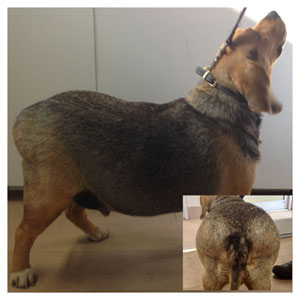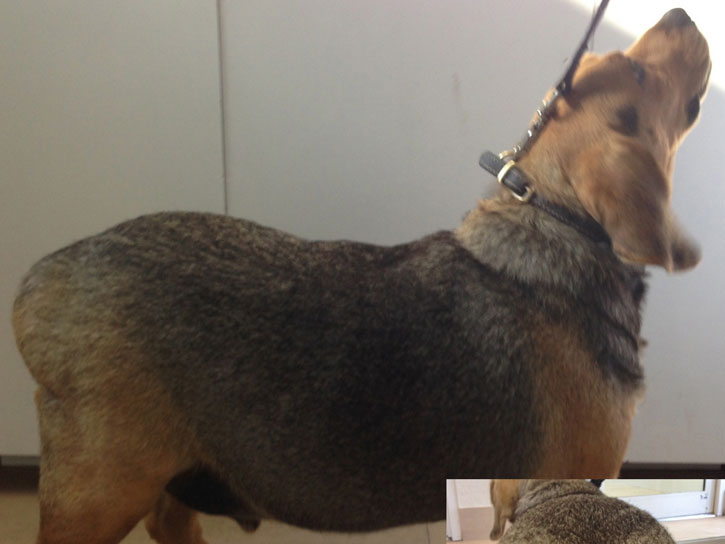Obesity has reached epidemic proportions not only among humans but also among our pets. While it is true that an increasingly sedentary life and an increased availability of calorie-rich pet diets are important factors contributing to obesity in dogs and cats, there are other factors too. Certain dog breeds have higher obesity rates than others. For example Labrador Retrievers, Dachshunds and Beagles, among others, are known to have tendencies towards obesity. Certain hormonal disorders can also contribute to obesity, such as hypothyroidism and hyperadrenocorticism (Cushing’s Disease). It is thought that, just like emotions can modify appetite in humans, the emotional states of dogs and cats can influence their appetite too. However, the main problems with pet obesity are that we fail to recognize that our pets are obese, have difficulty accepting it, or just discard the condition as a cute cosmetic problem. If the dog or cat has a belly that is not tucked in (hangs slightly instead), is lacking a well defined waist, or you have difficulty feeling the ribs when touching the sides of the chest, then the pet is obese.
The regulation of appetite is a complex process controlled mainly by the hypothalamus in the brain. Hormones from the stomach and fatty tissue, among other tissues, stimulate the hypothalamus to increase or decrease the appetite. Leptin is one of the hormones produced by fatty tissue. It functions like a thermostat for hunger and caloric burning; if the dog or cat is overweight, it will send a signal to the brain to decrease the appetite and increase that metabolic rate to burn the fat. The problem is that obese animals have high levels of Leptin in circulation and this will eventually facilitate building a resistance to it. This way, obese animals loose the check and balance system that keeps the levels of body fat under control. Leptin is also important because it induces chronic, mild inflammation of the tissues in the dogs and cat’s body. This inflammation produced by excess fat, will lead to chronic medical conditions such as insulin-resistance, Type- 2 diabetes, hypertension, cardiovascular disease, liver disease and even cancer. Obese dogs and cats will also experience more difficulty walking secondary to orthopedic or neurological conditions, lower energy levels, and a shorter life expectancy.
So what to do if your pet is obese? There are several steps you should take. A comprehensive physical exam will rule out any medical conditions contributing to obesity. Avoid high-calorie fatty foods and treats from the table and from commercial pet food manufacturers (bye bacon!), regardless of whether it is a dry, canned, raw, dehydrated, or frozen food. Offer healthy treats only, such a green beans, broccoli and pieces of fruits (no grapes). Feed the amount of food designated for your pets ideal weight, as described on the manufacturers labels. This is a good guide to start from. Measure the amount of food given daily, and divide that total amount into two meals a day. Consider “compartment bowls” to slow down fast eaters, giving the brain time to receive the message that the stomach is full.
For those dogs that enjoy stealing cat food, there are now automatic feeders that will open only when activated by a tiny device placed in a cat’s collar, and will close immediately if another device placed in the dog’s collar is detected. Minimally, dogs must be leash-walked 20 minutes once a day. Being loose in a yard does not guarantee the 20 minutes of non-stop aerobic exercise required to promote burning of fat. Cats can be trained to walk on a leash, or their environment can be enhanced to promote jumping, running and laser light playing. For more resistant cases of obesity, a veterinarian certified in rehabilitation can design a customized weight loss program consisting of a prescribed weight loss diet, an exercise plan that might include work in an underwater or land treadmill, and a home exercise prescription amongst other treatments. The rehabilitation veterinarian will monitor the dog or cat’s progress, and will modify the program as needed. To attack the obesity epidemic, it is required to first accept the obesity problem. Go and evaluate your dog or cat now. If they’re looking lean and healthy, congratulations on the good work. If otherwise, do not panic, let’s work on it. Your dog or cat will be thankful.
Dr Marta Sanchez-Emden is the founder of the Animal Health and Rehab Center in South Miami. She has been practicing Veterinary Medicine in Miami for over 20 years. As a Certified Veterinary Journalist, she is the resident veterinarian for various national TV shows. She authored the book “CHIHUAHUAS: How to Be Your Dog’s Best Friend,” available on Amazon. Follow her at youtube.com/ahrcvet, Facebook.com/dr.sanchezemden, Twitter @DrMartavet, and www.animalhealthrehab.com.





 Deering Estate
Deering Estate
 Massage Envy South Miami
Massage Envy South Miami
 Calla Blow Dry
Calla Blow Dry
 My Derma Clinic
My Derma Clinic
 Sushi Maki
Sushi Maki
 Sports Grill
Sports Grill
 The Healthy Kitchen
The Healthy Kitchen
 Golden Rule Seafood
Golden Rule Seafood
 Malanga Cuban Café
Malanga Cuban Café

 Kathleen Ballard
Kathleen Ballard
 Panter, Panter & Sampedro
Panter, Panter & Sampedro
 Vintage Liquors
Vintage Liquors
 The Dog from Ipanema
The Dog from Ipanema
 Rubinstein Family Chiropractic
Rubinstein Family Chiropractic
 Your Pet’s Best
Your Pet’s Best
 Indigo Republic
Indigo Republic




 ATR Luxury Homes
ATR Luxury Homes


 2112 Design Studio
2112 Design Studio
 Hamilton Fox & Company
Hamilton Fox & Company
 Creative Design Services
Creative Design Services
 Best Pest Professionals
Best Pest Professionals
 HD Tree Services
HD Tree Services
 Trinity Air Conditioning Company
Trinity Air Conditioning Company
 Cisca Construction & Development
Cisca Construction & Development
 Mosquito Joe
Mosquito Joe
 Cutler Bay Solar Solutions
Cutler Bay Solar Solutions


 Miami Royal Ballet & Dance
Miami Royal Ballet & Dance
 Christopher Columbus
Christopher Columbus
 Pineview Preschools
Pineview Preschools
 Westminster
Westminster
 Carrollton
Carrollton
 Lil’ Jungle
Lil’ Jungle
 Frost Science Museum
Frost Science Museum
 Palmer Trinity School
Palmer Trinity School
 South Florida Music
South Florida Music
 Pinecrest Orthodontics
Pinecrest Orthodontics
 Dr. Bob Pediatric Dentist
Dr. Bob Pediatric Dentist
 d.pediatrics
d.pediatrics
 South Miami Women’s Health
South Miami Women’s Health

 The Spot Barbershop
The Spot Barbershop
 My Derma Clinic
My Derma Clinic




 Miami Dance Project
Miami Dance Project

 Rubinstein Family Chiropractic
Rubinstein Family Chiropractic
 Indigo Republic
Indigo Republic

 Safes Universe
Safes Universe
 Vintage Liquors
Vintage Liquors
 Evenings Delight
Evenings Delight





 Atchana’s Homegrown Thai
Atchana’s Homegrown Thai
 Baptist Health South Florida
Baptist Health South Florida

 Laser Eye Center of Miami
Laser Eye Center of Miami
 Visiting Angels
Visiting Angels
 OpusCare of South Florida
OpusCare of South Florida

 Your Pet’s Best
Your Pet’s Best





 HD Tree Services
HD Tree Services
 Hamilton Fox & Company
Hamilton Fox & Company


 Creative Design Services
Creative Design Services